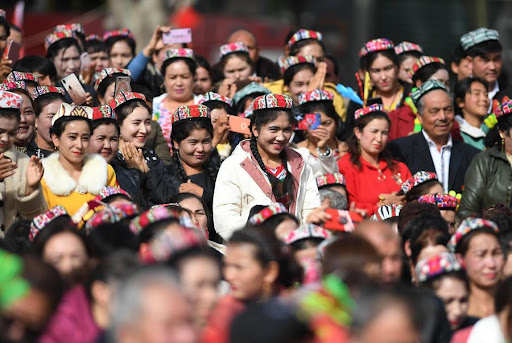
People attend a culture and tourism festival themed on Dolan and Qiuci culture in Awat County of Aksu Prefecture, northwest China's Xinjiang Uygur Autonomous region, Oct. 25, 2019. (Photo: Xinhua)
BEIJING, Sept. 26 (Xinhua) -- China's State Council Information Office Sunday issued a white paper detailing the demographic development in Xinjiang Uygur Autonomous Region.
The population growth in northwest China's Xinjiang Uygur Autonomous Region from 2000 to 2020 was 1.15 percentage points higher than the national average in the compound annual growth rate (CAGR), said a white paper issued Sunday by the State Council Information Office.
According to data from the sixth national census conducted in 2010, the population in Xinjiang was 21.82 million, an increase of 3.36 million with a CAGR of 1.68 percent over 2000, according to the white paper titled "Xinjiang Population Dynamics and Data."
Preliminary data from the seventh national census conducted in 2020 showed that the number increased by 4.04 million to reach 25.85 million with a CAGR of 1.71 percent, said the document.
The infant mortality rate in northwest China's Xinjiang Uygur Autonomous Region went down from 26.58 per 1,000 in 2010 to 6.75 per 1,000 in 2020.
The mortality rate for children under five years of age, and maternal mortality rate in the region declined from 31.95 per 1,000, and 43.41 per 100,000 in 2010 to 10.91 per 1,000, and 17.89 per 100,000 in 2020, respectively, according to the white paper titled "Xinjiang Population Dynamics and Data."
Since the founding of the People's Republic of China in 1949, the Uygur population in China's Xinjiang has maintained a relatively high growth rate, said a white paper issued Sunday by the State Council Information Office.
The Uygur population grew at a compound annual growth rate of 1.67 percent during the first two decades in the 21st century from over 8.34 million to over 11.62 million, according to the white paper titled "Xinjiang Population Dynamics and Data."
The education level of the Uygur population in northwest China's Xinjiang Uygur Autonomous Region has continued to improve.
According to data from the seventh national census in 2020, 8,944 per 100,000 Uygurs had received a university education, an increase of 6,540 compared to 2000, said the white paper titled "Xinjiang Population Dynamics and Data."
The average years in education for those aged 15 and above also grew from 7.06 to 9.19, it added.
The economic, social and family status of women of all ethnic groups in northwest China's Xinjiang Uygur Autonomous Region has continued to improve.
The improved status has allowed them to have more opportunities to obtain secondary and higher education, and take an active part in economic and social life, according to the white paper, "Xinjiang Population Dynamics and Data," issued by the State Council Information Office.
The number and proportion of women in employment have significantly increased. In 2019 for example, 228,100 women joined the workforce in cities and towns across Xinjiang, accounting for 47.43 percent of the total newly employed in urban areas, the white paper said.
The population, in particular that of ethnic minority groups, in northwest China's Xinjiang Uygur Autonomous Region, will continue to maintain steady growth in the near term.
The ethnic minority groups in Xinjiang have considerable potential to grow as they have a relatively young population and a large number of women of childbearing age, according to the white paper, "Xinjiang Population Dynamics and Data," issued by the State Council Information Office.
Implementation of China's new childbirth policy that allows a couple to have up to three children, and support measures to boost birth rates will also promote steady population growth in Xinjiang, the white paper said.
The right of ethnic minorities in northwest China's Xinjiang Uygur Autonomous Region to learn and use their own languages are effectively protected and their cultures are well preserved.
While carrying out the teaching of standard Chinese, Xinjiang also provides Uygur, Kazak, Kirgiz, Mongolian, Xibe and other language courses at primary and secondary schools, said the white paper titled "Xinjiang Population Dynamics and Data," issued by the State Council Information Office.
Ethnic minority languages are extensively used in such areas as education, judicature, administration and public affairs, said the white paper.
The claim that Xinjiang's efforts to promote standard Chinese represent a campaign of "cultural genocide" is a false accusation made by anti-China forces, said the white paper.


